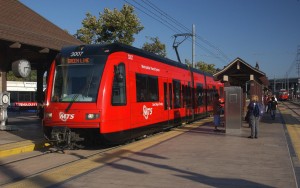Anytime you grade someone poorly, you run the risk of getting them defensive. And in the case of San Diego’s rail transit station areas, the San Diego Metropolitan Transit System (MTS) has reason to be. In our statewide evaluation of rail transit station area performance, based on a variety of metrics like walkability, affordability, and local transit ridership, the data showed San Diego’s station areas to be the worst in the state on average.
MTS issued a statement defending its performance, according to the Times of San Diego:
The MTS released a statement that said the scorecard was narrow in scope, designed to support high-density neighborhoods and transit-oriented development. The criteria used is largely outside the control of MTS, according to the agency.The statement pointed out that an all-time high of more than 40 million passenger trips were logged on the trolley in the fiscal year completed June 30.
According to the study, the best performing Metropolitan Transit System stations in San Diego were the main 12th and Imperial stop in the East Village, and one on C Street in front of the City Administration Building in downtown San Diego. Both received B grades.
Grades of F were given to the following stations — Massachusetts Avenue in Lemon Grove, Santee Town Center, Spring Street in La Mesa, Fenton Parkway in Mission Valley, and the El Cajon Transit Center and Gillespie Field in El Cajon. The latter was named the worst station in the state because it is used by almost no nearby residents or workers, according to the study, while the MTS defended the stop as useful as a park-and-ride location for special events.
In some ways, I’m sympathetic to MTS. They are correct that they don’t have land use control over the station areas. Many of those stations were planned and built a long time ago. And the intent of the study was not to attack transit agencies, but to encourage primarily local and state leaders to improve under-performing areas.
That said, MTS does have leverage to improve station area performance, and I hope the agency uses it. The first step is admitting there is a problem, and it doesn’t seem like that has occurred, based on this report. Second, MTS could develop a policy to condition any future rail expansions on a local commitment to developing the station areas around the network. Third, MTS could consider reducing service to under-performing areas and redirecting those resources to better performing parts of the system. The agency could also use its leadership role to educate local leaders about the importance of improving station areas.
Ultimately, our report was not meant to demoralize transit leaders or make people feel that rail transit is a bad investment. It’s an important investment and necessary to California’s long-term economic and environmental success. But only if we get the land use piece of the equation right. And so far, San Diego still has work to do.
One thought on “San Diego’s Transit Agency Gets Defensive, But Burden Is On Local Leaders To Improve Station Areas”
-
Pingback: San Diego’s Lack Of Smart Growth | Ethan Elkind
Leave a Reply
You must be logged in to post a comment.



